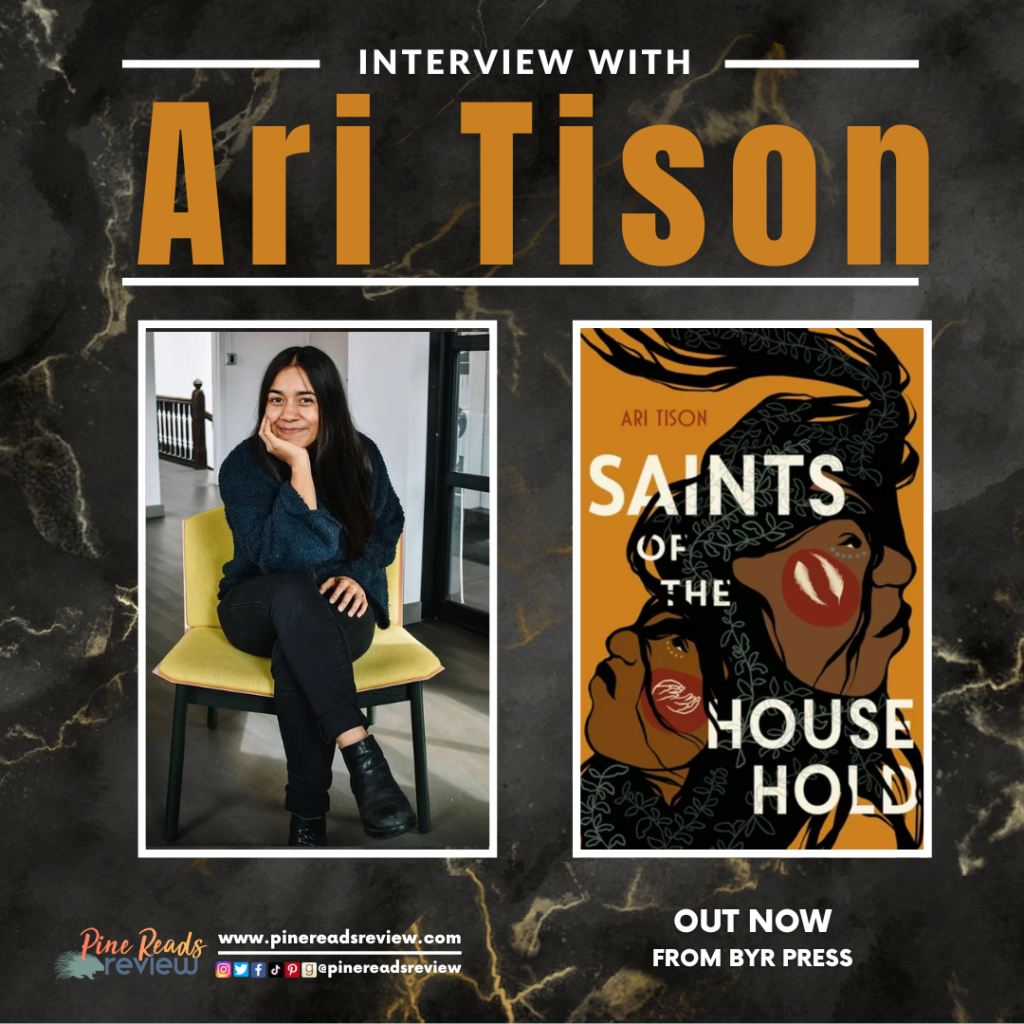
About the Author: “Ari Tison is an award-winning Bribri (Indigenous Costa Rican) American poet, essayist, educator, autoethnographer, and author of YA hybrid novel SAINTS OF THE HOUSEHOLD (2023) + Untitled YA (2025) with FSG/BFYR. Her short stories have been published or are forthcoming with OUR SHADOWS HAVE CLAWS with Algonquin Young Readers (2022) and RELIT with Harper Collins. Her poetry and essays have been published in various literary journals including POETRY’s first issue for young people. She has her MFA from Hamline University and now teaches in the MFAC program” (Bio from Author’s Website).
Find Ari Tison on the following platforms:
Ari Tison: It was so wonderful meeting you there, Mireya! It still remains one of my favorite festivals I’ve been to! As for the characters, I always wished I had siblings that were super close to me in age, like my sisters. They are 14 months apart and that inspired the close age gap between the two of them. But beyond that, I wish I could say they came from family members, but that’s about it!
AT: That’s such a good question! The vignettes came first in Jay’s voice, and then I wove in Max’s perspective in poetry. I loved them both as they both held different craft choices and challenges. I loved writing in Max’s point of view because I would write it on a Word document where two pages had to be side to side so the poetry was always in communication with the other poem it was next to. This helped me form white space and line breaks and sometimes it would help me decide on a shape for the concrete poetry! I think he was most challenging because I needed to get into the voice of a painter. I listened to so many artists talk about their work, and I took down words they said to build out his voice so that it was distinct from Jay’s.
I do love vignettes because they work well with my brain. I think I’m wired for it. I sometimes wish I could just write all my books in vignettes, but the truth is that I get bored too easily. I always want to try something new and push myself with each book in terms of form…so who knows when I’ll get to bring them back but they have to make sense for the project.
AT: When I first started writing Max’s voice, I had no idea that I would lean into concrete poems. In fact, I didn’t have language for what type of poetry it was. Then with play and experimentation, I had so much fun trying to match a visual with the internal landscape of Max that would show up like a poem’s version of a painting. It was so much fun. Challenging, but fun!
AT: I loved getting to co-translate Bribri stories with my Bribri mentor into English. To me it’s so special to have stories that have existed for much longer than colonization in this book. It feels special to have translations of stories available to other members of my tribe who are in the diaspora and don’t have as much access to our stories because we don’t live on the territory. I think of my brother, my cousin, my son, and others to come.
AT: So when I started writing SAINTS, I was not a plotter. The first many drafts of this book did have a fight, but there was no Nicole, no Luca. It wasn’t until my editor was like, Ari, we need a secondary plot to move this thing a bit more (bah, poet problems!), that I pushed myself to wonder what that fight really was and who was involved. Now, I can’t imagine the book without that plot and conflict. It brings so much more conversation and nuance to the book and allows the boys more individual paths rather than being fixated on their own relationship which is key to the book, but, of course, books are made up of lots of elements.
AT: I feel like those of us who have been in abusive spaces sometimes fear being like those who have most hurt us. Sometimes we might even use those same harmful tools because we have been entrenched in them and manipulated by them, and I wanted to give people permission to give themselves grace and offer themselves multiple ways to find healing.
I also wanted to give young people in any position of abuse permission to get help. There are lots of ways to get help of course. And these boys have many resources around them that they are learning to lean on—intergenerational relationships, intertribal relationships, counselors, a faith community, their passions, and also they have each other even if it takes a while to get there.
AT: I think Jay is the character I relate most to. I just love the way he thinks and observes the world. Writing in his voice was just like magic. He showed up right away, and I got to listen and write and write and write. It was such a special time. Not all characters are like that.
AT: Sometimes I wonder about returning to their voices, but Saints of the Household is a standalone novel. My next book is a YA novel out in early 2025. This one takes place partly in Costa Rica on my territory and is to the “thriller” side of things.
Thanks so much, Mireya! I appreciate you and your thoughtful questions!
Mireya Borgen, Pine Reads Review Editor & Writer